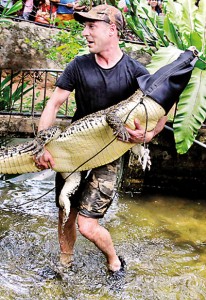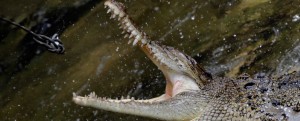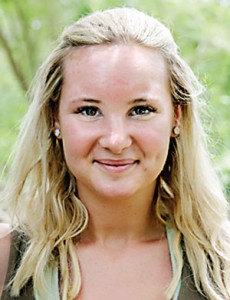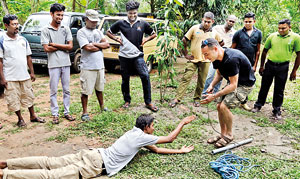‘Caught’ and then a hug for 7-foot croc!

Peter with the Salty in his arms at the Zoo
He lifts it up like a baby, lovingly and tenderly, not carrying it by its ‘arms’ but holding it around the middle of its body.
This is the nearly seven-foot, very aggressive Salty, a few minutes earlier that was thrashing about in the water, giving out guttural sounds, twisting and turning over and over again, with jaws snapping giving a clear view of the razor-sharp teeth which can inflict huge injuries.
Wide-eyed and on tenterhooks, we are standing very close to the shallow pond to watch an amazing feat, while a crowd of men, women and children stare in excitement from beyond the barriers of the crocodile enclosure at the Dehiwela Zoological Gardens.
It is diminutive Peter Prodromou, 33, at work. He is to Britain what Steve Irwin was to Australia.
A crocodile hunter or rather a rescuer!
It has been an exhilarating experience for us – shadowing every move that Peter depicts in the capture of crocodiles at the DWC office in the Bellanwila Wildlife Sanctuary and tailing him to the Zoo to see the talk being put into action last Sunday.
At Bellanwila, the ‘crocodile’ is a trainee, lying flat on the ground, while the reality of the skill needed in a capture, without endangering oneself and seriously injuring the crocodile is witnessed at the Zoo.
Peter is in Sri Lanka to train 50 personnel from the Department of Wildlife Conservation (DWC) on how to capture, restrain and transport crocodiles which are deemed to be causing trouble in communities. This is a joint project of the DWC and the Crocodile Specialist Group (CSG) South Asia and Iran, International Union for Conservation of Nature/Species Survival Commission (IUCN/SSC), under the direction of Dr. Tharaka Prasad, the Director of Wildlife Health, and Dr. Anslem de Silva, the Regional Chairman of the CSG, respectively.

Ready for a bite: The Salty at the Zoo. Pix by M.A. Pushpa Kumara
The ‘pacifier’ is the muzzle, explains Peter, demonstrating how with just one or two others, a noose is thrown to secure either the upper jaw or the lower jaw, depending on the terrain the crocodile is in and a stick (in this instance it is a broom) is used to gently prop up the snout of the creature so that the muzzle can be slipped over its snout and head.
And in this ‘Demonstration Croc Rescue’, at the Zoo, CSG member Avishka Godahewa is Peter’s invaluable ally, in the water near the crocodile, without batting an eyelid.
“The moment the crocodile’s eyes get covered, it calms down immediately,” says Peter, while the muzzle also stops its mouth from opening and allowing it to take a dangerous bite off the handler.
“Take your time, never be in a hurry,” he advises, for otherwise the croc will go crazy, crazy……..and don’t ever carry a croc by its arms, for the weight of its body will cause serious harm to it if dangled like that. “Crocodiles are not invincible. The hands will explode and you might as well shoot it because such an injury cannot be rectified,” says Peter who was in Sri Lanka from April 17. He leaves for Britain today after ‘catching’ many crocodiles in the wilds of Angammedilla in Giritale.
It is sandwiched between the theory-session at Bellanwila and the practical-session at the Zoo on how to capture crocs safely and humanely that we are able to chat with Peter and his partner, Natasha Lewis who is more into meerkats, hedgehogs and pets rather than dangerous animals. They work in tandem as she goes around, along with Peter who has formed the company, safaripete.co.uk, educating children and youth on the importance of co-existence with wild animals which brings in the funding for journeys to countries like Sri Lanka to train people.
He and Natasha also come bearing gifts in the shape of metal exclusion enclosures (kimbul kotu) to be installed in areas where people have to get about simple day-to-day activity like bathing or washing clothes in waters inhabited by crocodiles. Sri Lanka has two species of crocodile — the larger saltwater crocodile (Crocodylus porosus) or gata kimbula and the mugger crocodile (Crocodylus palustris) or hala kimbula.

Natasha Lewis
From Islington in London, for Peter, the lure of crocodiles came very early in life. When other little boys were playing with farm-sets, by the time he was six years old, he had substituted the shiny yellow ducks with scaly toy crocodiles.
Not only crocodiles, he was also fascinated by other venomous wildlife, a passion which is obvious as he urges the DWC staff to show him a slightly injured but large cobra that they are looking after until fit enough to go back into the wild, handling it with ease.
Challenged by learning difficulties as a child, the only books Peter loved to flick through were the wildlife kind. As he stared out of the classroom window rather than at his study books, the teachers let him out of school early to potter around a mini-zoo.
Handling animals for a few hours a day, however, was just not enough for him. He wanted a few all to himself and dipped his hand into a tank, picked up a baby caiman and hid it in his backpack. More followed — an iguana, numerous snakes including a python and a parrot.
By 16, he was on his way to Florida in the United States of America, where in the Everglades he jumped on an alligator in the wild. It was here that he taught himself the techniques of capturing wild alligators, without poring over zoology books or earning himself any biology degree.
No more does he catch animals for fun, only to remove so-called trouble-makers from among the people in various countries, so that they will not kill or harm the community and vice versa.
A highpoint of Peter’s life was when he caught a 15-foot crocodile at which the villagers of Katwe, in Uganda, were pointing an accusing finger as the killer of a teenager. Peter though is reluctant to call it a killer, for there had been two or three big crocodiles in the area and no one was sure which one was the culprit. Removal of all crocodiles from an environment would affect the entire eco-system, he says.
He smilingly reminisces how after catching another nine-foot Nile crocodile in Uganda there was simply no place to put it. “It was sent to jail,” he says, adding that a drunken man who was in the police cell was let out and the crocodile kept there until it was time to transport it to a different location.

A trainee is the croc for Peter’s demonstration at Bellanwila
Peter has also “slept with crocodiles” in vehicles by the roadside while transporting them but has never been bitten by any venomous creature or a crocodile, which technique he passes onto anyone he trains. This is while he works with the authorities to strengthen human-crocodile relationships.
As we bid goodbye to Peter, of course, giving the crocodile a wide berth, it is obvious that he is in no rush to release the Salty from his tender hug. The adrenalin rush every time he does what he loves to do, handling these apex predators, seems almost palpable.


